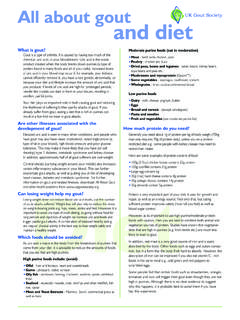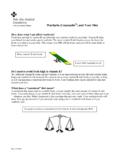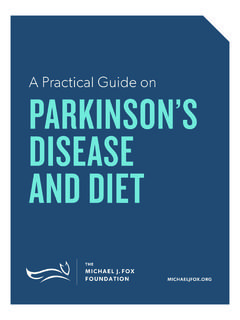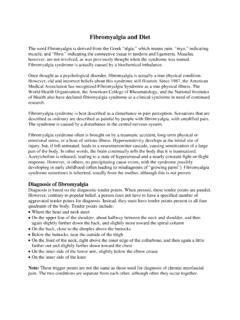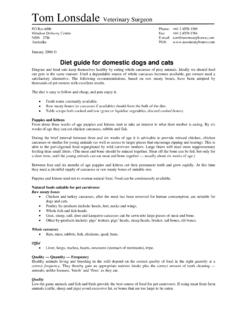Transcription of 2009 AboutGout v04 - Gout Education
1 About GoutWhat You Need to Know about Gout & Uric AcidPlus: How to gain control of symptoms A gout-friendly eating style Lifestyle changes that can help prevent future attacksabout Gout We re doing everything we can and more! IntroductionMore than million people in the United States are living with gout today. Gout is one of the most painful forms of arthritis and is the source of disability for many. This brochure is designed to help you understand the disease and how to gain control of it. With the right treatment, most people who suffer with gout are able to control their painful symptoms and maintain their normal with all medical conditions, patients should work with their physician for a treatment plan that s right for them.
2 For additional resources and the latest information, visit , our companion website. What is Gout?Gout is a form of arthritis. It is caused by an accumulation of uric acid crystals in the joints. The crystals form when there are abnormally high levels of uric acid in the is one of the oldest known diseases, known as far back as 4,000 years ago. Myths about its causes and treatment are common. One of the most popular myths is that gout is the disease of kings and other rich people and is caused by overindulgence. Today, gout is among the fastest growing diseases in the United States. Diet does play a role in the development of gout, but so do genetic factors and metabolic problems such as high blood pressure, diabetes, obesity and kidney gout attack is characterized by sudden and severe episodes of pain, warmth and swelling in a joint.
3 Gout typically strikes the large joint of the big toe, but may also affect other joints such as the instep, ankle, heel, knee, Achilles tendon, wrist, fi nger or elbow. When a person has had untreated gout for a long time, more than one joint may be Why the Big Toe? Half of first-time acute attacks strike the big toe. Ninety percent of patients will suffer gout of the big toe at some point during the course of the disease. Some believe that the big toe is most vulnerable because of the pressure it receives from walking. Others believe that uric acid crystals form more readily at cooler temperatures, and that the big toe is cooler than the central part of the body. Is Severe Pain Typical?A gout attack is extremely painful.
4 Some people report it feels like the affected joint is caught in a mechanical device. On a pain scale of 1 to 10, most gout patients rank their pain as a 9 or 10. Medical professionals generally agree that pain that a patient ranks as a 5 requires pain medicine. What is Uric Acid?Everyone has uric acid in their body. It is naturally present in small amounts. It is a waste product that results from the body s normal processes. Cells die and release chemicals called purines. Uric acid is made from purines. When we eat or drink high-purine foods, uric acid levels go up. High uric acid levels are part of what triggers a gout , uric acid is dissolved in the blood and passes through the kidneys and out into the urine.
5 But when more uric acid is produced than the kidneys can get rid of, high uric acid levels (known as hyperuricemia) develop. High uric acid may turn into crystals in the joints. When uric acid crystals accumulate in the joints they can make for a painful attack of What Are the Risk Factors for Gout?There are a number of risk factors for gout. The more risk factors a patient has, the greater the risk of the disease. With certain exceptions, gout develops in people age 45 or older. It affects men more than women, although once women are post menopausal, their rates of gout increase almost but not quite to the same level as men. Obesity someone with a Body Mass Index (BMI) of 30 or higher is classified as obese.
6 Visit for a link to a BMI calculator. Untreated high blood pressure, diabetes or high cholesterol Joint injury Use of certain medicines, especially diuretics or water pills and certain anti-rejection medications used in transplant patients Kidney disease, which can come from high blood pressure or diabetes A high-fructose diet, including sweetened soft drinks Genetics one out of four people with gout has a family history Hyperuricemia normal range for uric acid is 2-5 mg/dL What Can Trigger an Attack? Regular, excessive alcohol intake, especially beer or binge drinking eating large amounts of purine-rich foods, especially red meat, organ meat and shellfish Crash diets, especially high-protein fad diets A diet high in fructose, including soft drinks and fruit juices Starting a uric acid-lowering treatment medicine (even though it may be the correct long-term therapy) Surgery or a sudden, severe illness that puts a person to bed for a time Radiation therapy What Are the Treatment Options?
7 Through proper treatment and understanding of the disease, patients can avoid painful episodes and long-term joint damage and disability due to gout, and maintain their normal lifestyle as well. The goals of treatment are to: Ease the pain associated with acute attacks Prevent future attacks Avoid the formation of uric acid crystals, tophi (crystals under the skin) and kidney stones Reduce the risk of long-term damage to affected jointsFor most patients, medications and some changes to diet are the most effective way to control gout. Medications to Treat Gout Treatments to Relieve Pain and Reduce Swelling in Acute GoutColchicineTaken orally, colchicine may be most effective when taken within the fi rst 12 hours of an acute attack.
8 A common dosing schedule is to take two mg tablets together at once, then a third tablet one hour later followed by one tablet three times per day over the next week. Occasionally, patients may have side effects such as nausea, vomiting, abdominal cramps or diarrhea. Example: ColcrysGlucocorticosteroids (cortisone)Taken orally or injected, cortisone quickly suppresses the infl ammation of an acute attack. Examples: Medrol, Deltasone (Prednisone), KenalogNonsteroidal anti-infl ammatory drugs (NSAIDS)Taken orally, NSAIDS reduce the infl ammation caused by deposits of uric acid in the body. Examples: Aleve, Advil, Celebrex, Indocin, Motrin, Naprosyn6 Treatments to Lower Uric Acid Levels and Prevent Future AttacksAllopurinolTaken orally, allopurinol decreases the body s production of uric acid and is recommended for patients with a history of kidney stones or tophi.
9 Examples: Lopurin, ZyloprimFebuxostatThis medication is taken orally and decreases the body s production of uric acid. It can be taken by people with mild to moderate kidney or liver disease. Example: UloricPegloticasePegloticase is an intravenous infusion of an enzyme used to dissolve gout crystals in advanced and diffi cult to control gout. Example: KrystexxaProbenecidTaken orally, this medication increases the kidneys ability to remove uric acid from the body. It is not recommended if there is a history of kidney stones or renal impairment. Examples: Benemid, ProbalanClinical TrialsThere are also opportunities to participate in clinical trials. For more information about factors to consider and a list of clinical trials currently enrolling patients, visit names are registered trademarks of their respective experts agree that lowering a person s uric acid level to less than mg/dL is necessary to prevent gout fl ares and other problems from elevated uric physician will measure and monitor your uric acid level through a simple blood test.
10 A treatment plan that includes a combination of medication and lifestyle adjustments can lower uric acid levels to below mg/dL. It may take several visits to get to this goal but most gout patients will get up with your physician until you fi nd a treatment that is right for you. Be sure to mention all of the over-the-counter products you take, including herbs and vitamins. What Will Help Decrease the Pain of an Acute Attack? Avoid alcohol. Rest the affected joint for 24 hours after the initial attack or until the pain eases. Elevate painful joints. Apply cold packs wrapped in towels to the affected joints for 20-30 minutes several times per day. Relieve painful inflammation by taking one of the medications listed on page 6.



